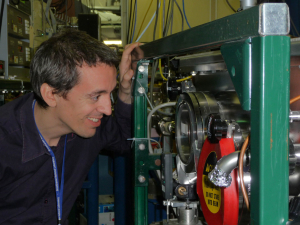Karim Benzerara, a scientist on the HERMES soft X-ray microscopy beamline was awarded the CNRS Bronze Medal for 2009 and the 2010 Houtermans Medal awarded by the European Association of Geochemistry. This makes us want to know a bit more about the background and research undertaken by this young scientist.
Karim, these two medals reward, in turn, “a scientist’s first research making him a specialist in his field” and the “research work of a young scientist under the age of 35 who has made a significant contribution in geochemistry”. What was this research on?
My research was based on studying interactions between microorganisms and minerals, or how microorganisms can form or break down minerals. It was aimed at improving our understanding of the mechanisms involved in these processes, based on detailed characterization of the minerals, but also of the biological polymers involved. There are several implications. The first is that these interactions leave traces in the rocks that could persist for billions of years. These studies help us understand better which traces of life to search for in rocks and what they can teach us.
The second implication is more environmental. Certain micro-organisms can form minerals that trap inorganic pollutants; others can break down minerals containing pollutants and thus participate in the release of pollutants. It is therefore important to learn the importance of these processes in the environment and the parameters controlling their variation.
Finally, there are, of course, implications for those interested in environmental microbiology (that is, how microorganisms interact with their surroundings), as well as medical implications, since certain pathological calcifications can originate from an infection.
What was your career path leading up to this research?
After a Ph.D. at the University of Paris 7-IPGP, obtained in December 2002, I was a post-doc at Stanford University, in Professor Gordon E Brown’s lab, where I discovered the use of synchrotron radiation and particularly scanning transmission X-ray microscopy (STXM) at the Lawrence Berkeley National Laboratory. In 2005, I was then offered a position at the CNRS, as “chargé de recherche” (junior researcher).
On HERMES, I will continue to work in the biomineralogy field (which can also be called Geomicrobiology).
What can the HERMES beamline contribute to your research?
Soft X-ray spectromicroscopy makes it possible to characterize the specifics of light elements such as carbon, nitrogen and sulfur, which are major components of biological polymers. It is also possible to study the speciation (notably the redox state) of heavier elements such as iron or arsenic, all on a nanoscale. Up to now, this has been the only instrument available for studying the systems that interest me and that combine the living with the mineral at a submicrometric scale.
Although at the beginning STXM beamlines in the soft X-ray field were only available in the USA, they have been developed over the last few years in Europe (SLS, Bessy II). Finally having access to such a beamline in France will be a great opportunity to go even further in exploiting its potential, by developing new methods of preparing, detecting and treating data and animating a diverse national community in terms of scientific themes and know-how.
What do you think you can bring to the HERMES group and users of this beamline?
I hope to bring my experience as a user of STXM (sample preparation, data collection and treatment); share my knowledge of the international community of STXM users and operators, in order to continually improve the performances of the microscope that will be installed. Finally, use my knowledge of the national communities in the earth sciences and the environment, as well as environmental microbiology, to further develop the HERMES beamline users’ community.
How would you like to see your work evolve – notably, in terms of research topics?
I foresee two main approaches over the next few years. On the one hand, to improve our understanding of biochemical agents, in the broadest sense (enzymes, polysaccharide polymers, etc.) involved in mineral formation by microorganisms. On the other, to improve our understanding of the consequences of mineral formation on cell physiology and viability and in particular, determine if mineral formation can be lethal, an advantage or neutral for cells or microbial populations.
HERMES will be a fantastic tool which will also require specific methodological developments and a better understanding of XANES spectra measured on complex samples, such spectra being very heterogeneous, a characteristic that is often inherent in the earth sciences, environment or heritage structures.
* The HERMES beamline (High Efficiency and Resolution beamline for x-ray Microscopy and Electron Spectromicroscopy) will be available to users in 2011.

Karim Benzerara carrying out a Scanning Transmission X-ray Microscopy (STXM) experiment at NSLS (Brookhaven), in March 2009.
